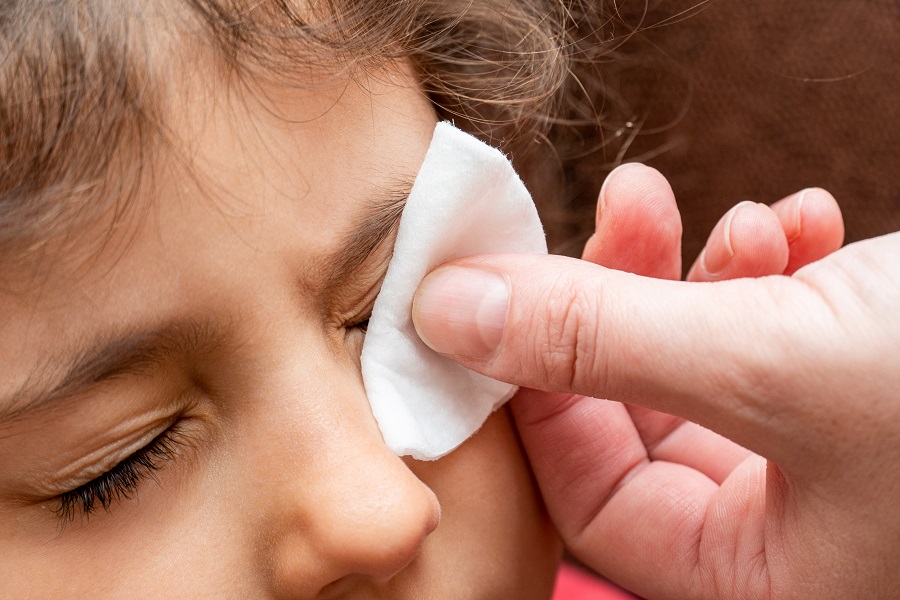Prevent the Spreading of Infectious Conjunctivitis

Infectious conjunctivitis is common among children. With school back in session, it may be helpful knowing the symptoms of conjunctivitis, how to treat them and how long your child will be contagious.
Infectious conjunctivitis, also called pink eye, is a highly contagious infection of the conjunctiva, a clear membrane that covers most of the eye. The majority of cases are caused by the same viruses that cause colds. Similar to a cold, it can easily spread from one child to another once the infected child touches or rubs their eye and then touches shared surfaces, such as a desk or doorknob. Some cases of infectious conjunctivitis can also be caused by bacteria, which can also be highly contagious.
What Are the Symptoms of Infectious Conjunctivitis?
Symptoms include redness, discharge, a gritty feeling and/or itchiness in one or both eyes.
- Bacterial conjunctivitis can include the above symptoms but also produces a thicker discharge in the eyes.
- Viral conjunctivitis also produces a significant discharge, but it tends to be more watery in nature.
Distinguishing between the two can be difficult, so parents should always discuss cases with a doctor.
How Long Is Pink Eye Contagious?
Your child is contagious once symptoms start and continues to be contagious until symptoms stop. Bacterial conjunctivitis can spread up to 24 hours after antibiotics are started. Since it’s highly contagious, you should contact your pediatrician’s office once you notice symptoms. This will help the pediatrician determine if your child needs treatment.
How to Relieve Symptoms of Infectious Conjunctivitis
Bacterial conjunctivitis will require antibiotic drops or ointment to clear it up. As with any antibiotic, the medication must be used for the entire length of time the pediatrician or eye doctor prescribes it. This helps prevent the infection from coming back.
Viral conjunctivitis is not treated with medications. It needs to run its course and will improve with time.
While your child is waiting for the infection to clear up, the following may ease eye discomfort. Try using a cool compress daily to help relieve inflamed eyelids and a clean single use wet wipe as needed to remove eye drainage. Use a separate wipe for each eye to avoid cross contamination if the infection is present in only one eye.
Control the Spread of Pink Eye
Your child should follow these tips:
- Stay home a minimum of 24 hours after starting antibiotics.
- Tell your child not to touch their eyes with their hands.
- Wash hands frequently.
- Change the towel and washcloth daily.
- Change the pillowcase daily.
- Clean eyes with warm water and clean gauze, cotton balls or washcloth, or single use clean wipe.
- Discard eye cosmetics and applicators. Don’t apply new eye cosmetics until the infection is completely gone.
What to Do About Contact Lenses?
If your child wears contact lenses, she may be more prone to contracting pink eye. If any symptoms appear, stop wearing contacts until symptoms disappear completely.
- Discard contact lenses and lens case that have been used while the child has symptoms of conjunctivitis.
- When symptoms completely resolve, start a new pair of contact lens.
- In addition to not sharing makeup, don’t share contact lens or eye drops with others to avoid contracting or spreading conjunctivitis.
How to Differentiate Allergic Conjunctivitis from Infectious Conjunctivitis?
Many children have allergies that may affect their eyes, called allergic conjunctivitis, which is not contagious. They may show symptoms of allergic conjunctivitis, including redness, itchiness, discharge and a gritty sensation. Many of these symptoms overlap with infectious conjunctivitis and it may be difficult for parents to tell the difference. Further, children with allergic conjunctivitis can also develop infectious conjunctivitis, especially when these children rub their itchy eyes.
It’s important to control allergic conjunctivitis and prevent excessive eye rubbing, which can lead to infections and increased risk of developing a condition called keratoconus. One hallmark of allergic conjunctivitis is the itchiness, which is frequently the main complaint. When you aren’t certain, it’s best to see an eye doctor to diagnose which type of conjunctivitis your child is having: allergic, viral, or bacterial, as the treatments can be different. For allergic conjunctivitis, both over-the-counter allergy eye drops and prescription anti-inflammatory eye drops are used to control symptoms.
Guest Blogger: Juan Ding, OD, optometrist at UMass Memorial Eye Center
Related: There Are No "I's" (Eyes) in Menopause ... or Are There?
Note: The content of this blog is for informational purposes only. It is not intended for use as diagnosis or treatment of a health problem or as a substitute for the professional consultation of a physician or qualified health care provider. If you have specific questions or concerns regarding a health or medical condition, contact your physician or a licensed health care professional.

